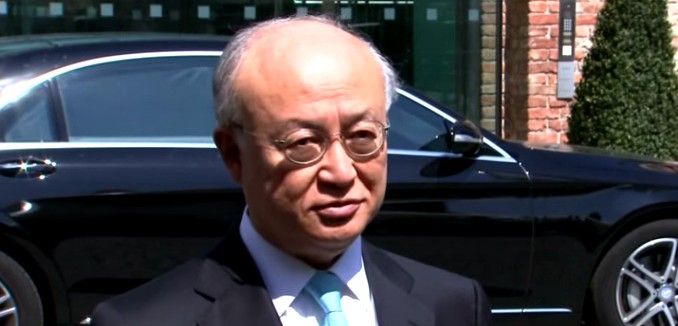Over the past year, International Atomic Energy Agency (IAEA) Director General Yukiya Amano has consistently asserted his inability to guarantee that Iran’s nuclear program is exclusively peaceful. Yet, according to news reports, the United States intends to move forward with the nuclear deal, including the lifting of nuclear-related sanctions imposed on Iran. This would give Iran a pass on its obligation to explain the possible military dimensions of its past nuclear research and pose a threat to the agreement’s verification provisions, which are supposed to be central to preventing the Islamic Republic from developing nuclear weapons.
Without knowing the full scope of Iran’s past nuclear work, including its research into detonating nuclear bombs, it will be impossible to determine Iran’s compliance with the deal in the future.
In his address to the IAEA Board of Governors last week, Amano emphasized, “we are not in a position to provide credible assurance about the absence of undeclared nuclear material and activities in Iran, and therefore to conclude that all nuclear material in Iran is in peaceful activities.”
If this sounds familiar, it should. Amano made similar comments about Iran’s nuclear program on numerous occasions over the past year. In November of last year, the director general said, “The IAEA has been addressing this issue of Iran nuclear issues for more than 10 years but we still cannot give the assurance that all of the activities in Iran are for peaceful purposes.” In January of this year, he noted, “we are not in a position to provide credible assurance about the absence of undeclared nuclear material and activities in Iran, and therefore to conclude that all nuclear material in Iran is in peaceful activities.” In March, Amano repeated this theme, saying, “Iran was not providing sufficient cooperation to enable the Agency to conclude that all nuclear material in Iran was in peaceful activities.”
When the nuclear deal was announced in July, Amano explained, “The Additional Protocol enables us — over time — to provide credible assurances to the world that all nuclear material in a State remains in peaceful activities. With Iran’s full cooperation in implementing its Safeguards Agreement and Additional Protocol, we hope that, in time, we will be able to provide such an assurance for Iran.”
What has been consistent in Amano’s pronouncements over the past year – both explicitly and implicitly – is that his agency cannot guarantee that Iran’s past nuclear work has been exclusively peaceful.
It is important to keep Amano’s consistency in mind while reading recent news about the IAEA’s soon-to-be-released report on the possible military dimensions of Iran’s past nuclear work. Amano has been quoted as saying that the agency’s report is a “jigsaw puzzle” or that it’s “not black and white,” but these comments confuse the main issue at hand. During the nuclear negotiations, the administration insisted that resolution of Iran’s past nuclear work and its possible military dimensions were essential to a deal. Proceeding with the deal in the absence of the resolution of those questions would be a retreat in the administration’s position.
The Wall Street Journal‘s coverage (Google link) of the upcoming IAEA report has been the most complete. According to the Journal, the United States is eager to lift sanctions on Iran, claiming that “Iran complied with all the formal steps in the IAEA probe.” However, the Journal also quoted unnamed diplomats who noted that, while Iran formally met the deal’s requirements, it has actually provided little new information to the IAEA and in fact blocked access to a number of individuals and documents that the agency requested.
The result is that, despite the deal, the IAEA cannot guarantee that Iran’s nuclear program has always been exclusively peaceful.
When President Barack Obama defended the deal in a speech at American University in August, he said, “After two years of negotiations, we have achieved a detailed arrangement that permanently prohibits Iran from obtaining a nuclear weapon. It cuts off all of Iran’s pathways to a bomb. It contains the most comprehensive inspection and verification regime ever negotiated to monitor a nuclear program.”
However, the IAEA will be the agency in charge of verifying Iran’s compliance. By accepting less than the IAEA requires of Iran in reporting its past nuclear work, the administration would ensure that the full scope of Iran’s nuclear program is impossible to verify. Furthermore, by watering down the requirements that Iran must adhere to, the administration is also setting a precedent for undermining the IAEA’s ability to determine Iran’s compliance in the future.
Writing about the Parchin deal that allowed Iran to self-inspect the suspected nuclear site, David Albright, Olli Heinonen, and Serena Kelleher-Vergantini — respectively the former deputy director general of the IAEA, the executive director of the Institute for Science and International Security, and a research analyst at the institute — argued (.pdf) that “the Parchin agreement could be a presage of the undermining of the IAEA’s ability by its December 15, 2015 deadline to adequately address its concerns about past and possibly ongoing Iranian work related to nuclear weapons. Later, the precedent of the Parchin deal could weaken the IAEA’s ability to verify the JCPOA.”
Similarly, in regards to the possible military dimensions of Iran’s nuclear program, any weakening of the IAEA’s conditions would erode the agency’s ability to monitor Iranian compliance. If President Obama and his administration don’t insist that Iran fully explain its past nuclear work to the IAEA’s satisfaction, they can’t be serious about verifying that Iran will not develop nuclear weapons.
[Photo: IAEAVideo / YouTube ]




